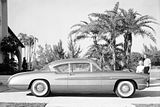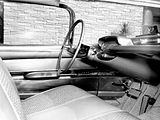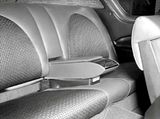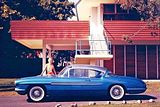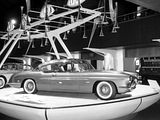More than once, Chevrolet designers have toyed with the idea of a four or five-place Corvette. One of them even joined the GM Motorama show car fleet for a time. Here’s the story of the 1956 Corvette Impala. Work began on the five-place Corvette project, known internally at GM as XP-101, in July of 1955, and the Impala made its first public appearance in the General Motors Motorama at the Waldorf Astoria Hotel in New York on January 19, 1956. GM stylists Carl Renner and Bob Cadaret included key elements of the two-seater production Corvette in the Impala’s look, including the large, Italianate radiator opening in the front, filled with a chrome grille bar with 13 sparkling teeth. (Production 1953-1957 Corvettes used the same number of teeth, coincidentally.) Discrete badging on the front header panel and rear deck indicated that despite the rear seat, the Impala was indeed a Corvette. The body—fiberglass, naturally, with a brushed stainless roof panel—rode on a conventional Chevy passenger car-type chassis with 116.5-inch wheelbase, with short-long arm independent front suspension and Hotchkiss drive with leaf springs at the rear. A Corvette 265 CID V8 equipped with two-four-barrel carbs and rated at 225 hp was coupled to a Powerglide two-speed automatic gearbox, with the exhaust pipes snaked through the driveshaft tunnel. All fairly typical stuff underneath, though real wire wheels with knock-off hubs supplied some sports car flavor. Where the Corvette Impala broke new ground was in its innovative styling and interior. A folding armrest allowed occasional three-abreast seating in the front, with room for two more passengers in the coupe’s rear seat. The dramatic Interior fabrics were blue vinyl with a contrasting silver cloth in a heavy crossweave pattern. Instruments and controls were concentrated in a module directly in front of the driver, with an unusual speedometer that featured a horizontal array of sequential lamps that lit up in progressively brighter red as vehicle speed increased. Originally finished in metallic turquoise, the Impala was repainted in medium metallic blue for the 1957 Motorama show season, and it made its debut in the new color at the Chicago Auto Show that year. While the Impala was said to be fully roadworthy, unlike many GM show cars, it was reportedly scrapped at some point after the ’57 show season, unfortunately. As we know, there would never be a production Corvette with a rear seat, though there were a few more experiments. However, two of the show car’s features did find their way into Chevrolet showrooms in 1958: the novel reverse-angle C pillar, and the Impala nameplate, which is used on Chevrolet passenger cars to this day. Appearing at the 1956 GM Motorama show was the Corvette Impala. This five passenger conveyance featured a Corvette grille and grille surround, as well as other Corvette components. The Corvette Impala emblem on the front, and rear license plate, led show-goers to believe that the Corvette was to become a passenger car. Show goers had no idea how correct they were, as Chevrolet built this Corvette-inspired passenger car to find out if such a vehicle was desirable. Apparently, the design did not garner the appeal that Chevrolet was hoping for. Not only did the car have design features from the Corvette, it also sported the 265 cubic-inch V-8 from the production two-seater. Just like the Corvette, the Corvette Impala was built with fiberglass body panels. |
|



